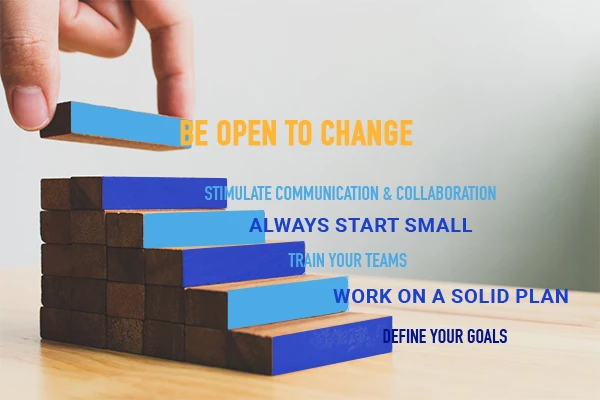
A Guide to BIM Implementation
If you can’t decide how to implement BIM into your projects, then know that you have come to the right place. In our today’s blog, we will discuss what BIM is and share useful tips for effective BIM implementation. Make sure that you guys read the blog till the end to know more and decide better!
What is Building Information Modelling (BIM)?
BIM is a tool through which you can generate and manage digital representations of a structure’s physical and functional characteristics. In easy-to-understand words, BIM facilitates designers, architects, modelers, contractors, facility managers, etc. throughout the lifecycle of a project. In addition to that, BIM also happens to offer project and resource management and risk mitigation.
Since conventional building methods are becoming outdated; there was a dire need to introduce a new digital process that could do things more efficiently. Thanks to the presence of BIM; it now has become a preferred choice for many individuals associated with the construction and architecture sectors.
Top 6 Key Features of BIM

In this part of the blog, we will highlight a couple of features of the BIM process.
1. 3D Modelling
The process of BIM starts with the creation and generation of highly detailed 3D models. These 3D models can be created from scratch or by leveraging existing building data. Scan to BIM services, for instance, use 3D laser scanning to capture existing structures and convert that data into a BIM model. This allows stakeholders to have access to intricate details of existing buildings. In simpler words, these models are the digital prototypes of buildings and infrastructures and are quite helpful for informed decision-making
2. Data Integration
Once the stakeholders have access to the necessary data, they can integrate it into digital models. This data covers various fronts. Such as spatial relationships between building elements, geometric information, materials and quantities. In addition to that, the performance of such elements can also be measured through BIM.
3. Collaborative Working Environment
One of the best features of BIM is that it offers collaborative working environments. We all know how important it is for each stakeholder to communicate and collaborate for project delivery. So, when BIM is implemented into a project, the stakeholders get to work in a centralized platform which fosters real-time exchange of information.
4. On-point Visualization
When BIM is implemented into a construction project, the stakeholders can thoroughly visualize the designs and processes that follow. The visualization feature offers realistic 3D rendering, simulations and animations when required.
5. Computational Analysis and Simulation
Through BIM implementation, the stakeholders can also carry out in-depth analysis of certain aspects concerning a construction project. These aspects can include energy efficiency, cost estimation, clash detection, load-bearing capacity, etc. Such information is crucial for ensuring the successful completion of the project.
6. End-to-End Management
When BIM is implemented into a construction project, it does not take off as soon as a built environment is completed. BIM allows the lifecycle management of an infrastructure or a building. Allow us to explain that this support begins at the conception of a project and covers the planning and design phases till its construction. Then it also covers the operational and maintenance phases. If required, BIM can also provide support in the decommissioning process.
Now that you have read in detail what BIM is, it’s time for us to share useful tips on how to implement BIM!
9 Easy Steps to Implement BIM in Your Construction Projects

The implementation of BIM has been a groundbreaking step in construction projects. As you have read about its benefits in the blog’s former part, we would like to dive right into the practical steps.
1. Define Your Goals
Without a clear set of goals, you don’t stand a chance to enjoy the maximum potential of BIM. And no, we are not trying to scare you guys. What we do want you to know and understand is that you must define your goals before you opt for BIM implementation. A couple of goals to look out for include; efficient project management, risk reduction, cost-effective solutions or stakeholders’ collaboration.
We can assure you that when you have defined your goals, you will ensure the successful delivery of your projects.
2. Work on a Solid Plan
Speaking of goals, another useful tip to follow for successful BIM implementation is designing a solid plan. Ensure that this plan is followed during your project’s lifecycle. And while you are at it, allow us to share what it can do for you! When you develop a plan to work on, you’re halfway there to get your desired results. So, to get what you’re expecting from your construction project, your BIM Implementation Plan (BIP) needs to be ready.
Also, BIP is not just a document to assign roles but it also enables teams to set clear objectives and project requirements.
3. Train Your Teams
Although you will hire a third party for BIM implementation into your projects, you must also get your teams trained. And no, you won’t be overdoing it. Here is why: when your teams have the necessary knowledge to understand BIM and its processes, they will be able to effectively utilize it as well. Always remember that access to the necessary knowledge and skill set always helps in the long run.
4. Determine & Implement Your Standards
You’ll create standards such as how models will be created, how you will streamline the internal process, and how you’ll achieve representational and technical standards that apply to the deliverables.
Standards for the way in which the models are created, the internal processes used, and the technical and representational standards that apply to the deliverables will also be needed. If you are in the steps to successful BIM implementation, this will be your roadmap.
Another important investment in BIM implementation process will be you taking the time to analyse and document the processes required to deliver BIM. This documentation will be a useful checklist to ensure all impacts are considered and ensure that your new process will take account of existing interconnected systems and procedures.
5. Tools to be Used
Another important consideration is to craft a clear plan of what tools you’ll use during the whole project lifecycle. Whether your client wants Revit implementation or he/she wants to integrate BIM with existing construction processes through different software, it’s crucial to clearly define these tools from the outset. This ensures alignment on the technical approach, enhances efficiency, and allows for seamless integration tailored to the client’s specific needs.
6. Always Start Small
Don’t wish to feel overwhelmed after implementing BIM and its processes all at once? Then don’t. Yes, that’s quite literally the tip that you must follow when it comes to incorporating BIM into your projects.
Allow us to share the reasoning behind it. When you start small and then gradually scale up, you let yourself sift through the possibilities. Once you are sure that you are on the right track, you can delve into it altogether. By doing so, you will know if you want to expand BIM across all your projects or if you want to keep testing the waters.
7. Stimulate Communication & Collaboration
When it comes to construction projects, communication and collaboration play a vital role. This implies that when BIM is implemented, you must ensure that you’re fostering enhanced communication among teams. Let us explain how stimulating communication and collaboration, you can get your desired results.
First things first; communication within teams shouldn’t be restricted to a certain phase or discipline. Secondly, it must always be practiced throughout the project’s lifecycle. And maybe even after the construction has been completed; if need be. By fostering effective communication and collaboration, you will mitigate potential risks and get done with things in style.
8. Be Open to Change
We understand that transitioning from old building methods to BIM can be difficult and at times, disruptive. But if you’re planning to make better, more sustainable choices, then BIM is the only way to go about it. When you are open to change, so will your teams. What we mean to say is that for a smooth transition into BIM, you need to work towards effective change management.
You can talk about how BIM is beneficial for project management, meeting tight deadlines and is also cost-effective. Effective change management will also encourage the adoption of BIM in all big and small projects.
9. Prepare Yourself for the Worst
In an ideal world, your software would work as required on day one, that function you’ve built a process around would integrate perfectly with minimum effort, and your hardware would be up to the job of running everything you throw at it. Life tends not to work that way.
Considering the possible risks at every stage of the process and monitoring and mitigating these risks will be essential to keeping the project on track.
Having said that, it’s now time for you to contact us today to embark on a journey of successful BIM implementation. Let us share why!
At DDC Solutions, we will ensure a smooth BIM implementation after offering you bespoke BIM services. In addition, our experts are ever-ready to help you stay on the right track for your projects – guaranteeing seamless project delivery.


7 Responses